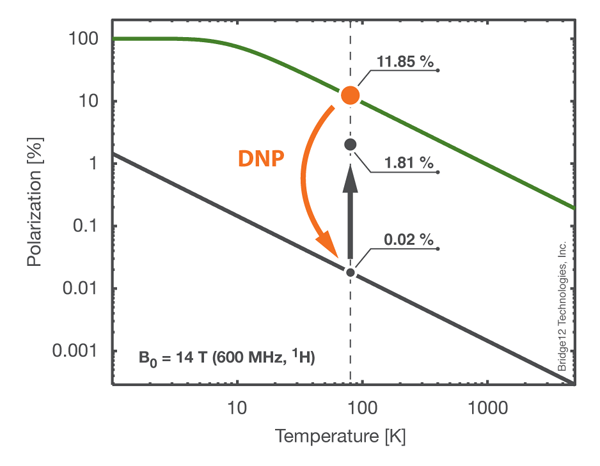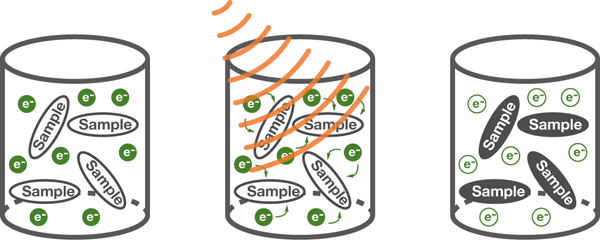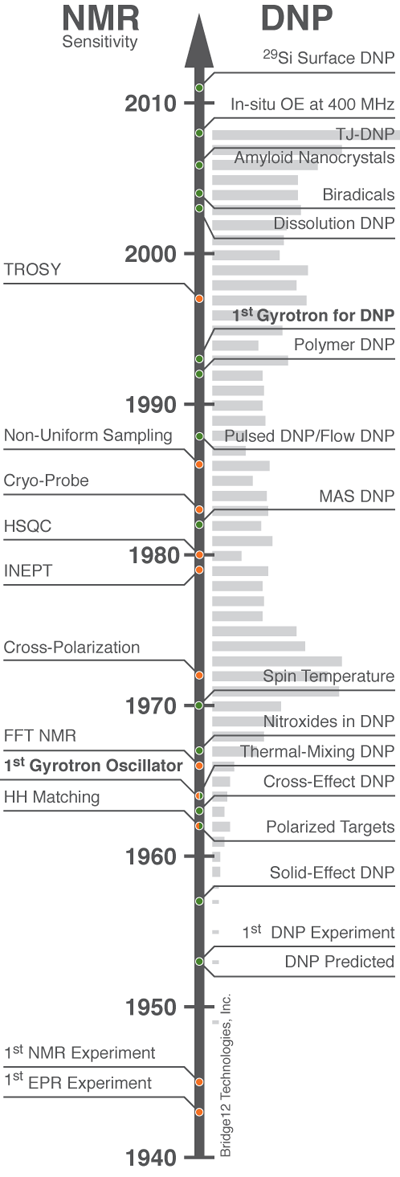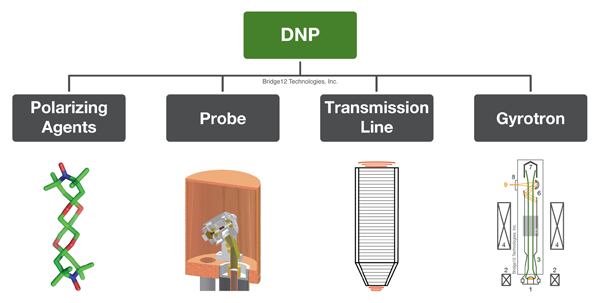What is Dynamic Nuclear Polarization (DNP)?
Researchers can use dynamic nuclear polarization (DNP) to boost signal intensities in nuclear magnetic resonance (NMR) experiments, a technique known as DNP-NMR spectroscopy.
NMR spectroscopy is an important technique for structure determination in material science and structural biology. However, its major drawback is the inherent low sensitivity of the method due to the small magnetic moment of the nuclei under study (1H, 13C, 15N etc.). This directly results in a small polarization of the nuclear spin reservoir (difference of number of spins aligned parallel or anti-parallel to the external magnetic field) and signal intensities are small. Often extensive signal averaging is required to obtain a sufficiently high signal-to-noise ratio.

Figure 1: Temperature dependence of the electron and nuclear spin reservoir polarization at a given external field strength of 14 T, corresponding to a 1H nuclear Larmor frequency of 600 MHz.
How Does Dynamic Nuclear Polarization (DNP) Work?
DNP is a technique that utilizes the large Boltzman polarization of the electron spin reservoir to provide a boost in NMR signal intensities by several orders of magnitude; thus increasing the data acquisition rate in a NMR experiment dramatically (Maly et al., Barnes et al.). In a DNP experiment the large electron polarization of a polarizing agent is transferred to surrounding nuclei (typically protons, 1H) by terahertz (microwave) irradiation near or at the electron paramagnetic resonance (EPR) transition. With signal enhancements of several orders of magnitude, the method is extremely valuable to overcome the intrinsic low sensitivity of liquid- and solid-state NMR experiments in applications ranging from particle physics (Goertz et al.) to structural biology (Maly et al., Barnes et al.) and clinical imaging (Gallagher et al.).
The Electron spin reservoir has much larger polarization
The proton polarization at a magnetic field of 14 T (corresponding to 600 MHz proton Larmor frequency) is shown in Figure 1 (grey line). While the polarization increases with decreasing temperatures it still remains well below 1 %, for temperatures above 1 K. In contrast, at the same magnetic field and temperature, the polarization of the electron spin reservoir (e.g. free, stable paramagnetic polarizing agent) is significantly larger due to the much higher magnetic moment of the electron spin. This behavior is shown in Figure 1 (green line). For example, at a temperature of 90 K the polarization of the proton (1H) spin reservoir is 0.016%, while it is 10.541% for the electron spin reservoir, a factor 660 times larger. This difference in polarization is given by the ratio of the electron to proton gyromagnetic ratio. A complete list of gyromagnetic ratios can be found on the (NIST web page).
DNP leverages the electron polarization to enhance signal intensities for NMR
DNP-NMR makes it possible to transfer the large Boltzman polarization of the electron spin reservoir to the nuclear spin reservoir to provide a boost in NMR signal intensities by several orders of magnitude; thus increasing the signal intensity and data acquisition rate in a NMR experiment dramatically.
DNP spectroscopy is no new scientific area. First DNP-NMR experiments were performed in the early 1950s at low magnetic fields (Abragam et al.) but until recently the technique was of limited applicability because of the lack of high-frequency, high-power terahertz sources. Briefly, in DNP-NMR spectroscopy, the large electron polarization of a polarizing agent is transferred to surrounding nuclei (typically protons, 1H) by terahertz (microwave) irradiation near or at the electron paramagnetic resonance (EPR) transition. The electron spin system (polarizing agent) required for DNP spectroscopy can either be an endogenous or exogenous paramagnetic system.
For liquid-state NMR the only DNP mechanism currently known is the Overhauser Effect (Overhauser) while for solid-state different DNP mechanisms can employed such as the solid-effect, thermal-mixing or the cross-effect (Maly et al., Barnes et al.).

Figure 2: Schematic representation of the DNP process. Without DNP the sample is in its thermal equilibrium state. The DNP process is initiated and driven by microwave irradiation of the sample. During this process the large thermal polarization of the electrons spin reservoir is transferred to the nuclear spin reservoir.
At high magnetic fields, the cross-effect is the mechanism that yields the largest signal enhancements in dynamic nuclear polarization solid-state NMR experiments. The cross-effect can be exploited, if the homogenous linewidth (δ) and the inhomogeneous breadth (Δ) of the EPR spectrum of the paramagnetic polarizing agent, is larger compared to nuclear Larmor frequency (ω0I). The underlying mechanism is a two-step process involving two electrons with Larmor frequencies ω0S1 and ω0S2 separated by the ω0I (matching condition) (Barnes et al., Blombergen]. The DNP-enhanced nuclear polarization then disperses throughout the bulk via spin diffusion (Blombergen). To date most polarizing agents for high-field DNP experiments are based on nitroxide based moieties (e.g. TEMPO), which employ the cross-effect (CE) as the DNP mechanism. No sample-shuttling is necessary, which makes in-situ, solid-state DNP spectroscopy a straightforward approach to combine with solid-state NMR spectroscopy. For high-field, DNP-enhanced solid-state NMR spectroscopy biradicals such as TOTAPOL or bTbk are very efficient (Song et al., Matsuki et al.). For liquid-state DNP experiments TEMPO can be simple added to the solution.
The Development of DNP-NMR

Figure 3: The Development of Dynamic Nuclear Polarization NMR Spectroscopy
DNP-NMR spectroscopy is not a new technique. It was first proposed in 1953 by Albert E. Overhauser and experimentally confirmed by Carver and Slichter the same year. However, while NMR spectroscopy was pushing for higher and higher magnetic fields to gain resolution and sensitivity, the advances in microwave and millimeter wave technology could not keep up with the trend to higher frequencies and relegated DNP as an exotic method.
The first application of DNP started in the early 1960’s to generate polarized targets for solid-state physics experiments. Almost all known DNP mechanisms that are still in use today, namely the solid-effect (SE), the cross-effect (CE), thermal-mixing (TM) and the Overhauser-Effect (OE) were discovered in these early years of DNP spectroscopy. At the same time, theoretical descriptions of the mechanisms were developed based on the spin-temperature concept.
In the 1970’s DNP was extensively used in solution state NMR experiments to study molecular motions and interactions in solutions (work by Hausser/Stehlik and Mueller Warmuth). These experiments were typically limited to frequencies up to 60 MHz (1H) corresponding to an electron Larmor frequency of 39 GHz.
While NMR spectroscopy migrated to ever-higher magnetic fields, DNP couldn’t keep up due to the slower pace of advances in microwave technology. However, during the 1980’s and 1990’s, the interest in solid-state DNP grew to enhance the sensitivity in solid-state (magic-angle spinning) NMR experiments (work by Schaefer to study polymers and Wind to study coal).
The modern DNP area started in 1993 with the first use of a gyrotron as a high-frequency/high-power source. For the first time the method was no longer limited by the availability of high-power THz sources. The initial focus was to enhance solid-state NMR experiments for structural biology—with one of the first examples being DNP-enhanced ssNMR experiments to study membrane proteins.
At the same time new polarizing agents were developed. Until the early 2000’s stable, organic (mono-) radicals (e.g. BDPA, nitroxides) were typically used, with reasonable performance. However, a better understanding of the involved polarizing mechanisms lead to the development of bi-radicals, with TOTAPOL a polarizing agent that is soluble in aqueous media, giving much larger DNP enhancements compared to nitroxide-based mono-radicals.
The recent improvements in instrumentation and the availability to perform DNP-enhanced ssNMR at high magnetic fields has led many scientists to revisit the technique, and applications in structural biology and material science have been reported. This can be seen by the numbers of research articles published in the field; since the early 2000’s this number has been exponentially growing.
The challenges in high-field, solution-state DNP experiments are even bigger than in ssNMR spectroscopy due to the high ohmic losses of the sample and the heating effects associated with it. For in-situ experiments, THz resonators are required to separate the electric and magnetic field components of the THz radiation. At high frequencies, the physical dimensions of these resonators become very small, making it a very challenging task to fabricate them.
Alternative methods for polarization were developed in the early 2000’s with dissolution DNP being one of the most successful concepts currently employed. Improvements in THz and RF technology have led to new solution-state probe designs and in-situ OE solution-state DNP experiments were very recently reported in which the sample is directly polarized at 400 MHz (9.5 T, 268 GHz e-) using a very small resonator.
Overhauser DNP Spectroscopy
Overhauser Dynamic Nuclear Polarization (ODNP) enhanced NMR spectroscopy at 9 GHz (0.35 T, 15 MHz 1H NMR frequency) is a powerful method for site-specific studies of hydration dynamics at or near bio-macromolecules, membrane proteins, or other solid/liquid interfaces (for example see Franck et al., or Kaminker et al.). In addition ODNP can be used to enhance the signal intensity in low-field NMR spectroscopy(for example see Keller at al.). Although the method has been known since the 1960s, it has just recently been successfully applied in structural biology and material science. The unique instrumentation requirements had previously limited the application of ODNP-enhanced NMR spectroscopy, specifically the lack of commercially available microwave sources and DNP resonators.
How to Upgrade Your NMR Spectromters for DNP
Four different components are required for dynamic nuclear polarization (see Figure 4): 1) A polarizing agents (typically a biradical), 2) A low-temperature NMR probe that allows simultaneous irradiation of the sample with THz and RF power, 3) A transmission line that delivers the THz power from the source to the sample and 4) A microwave/THz source such as a gyrotron.

Figure 4: Components of a DNP-NMR system. From left to right: Polarizing agent, DNP-NMR probe head, transmission line, microwave/THz source.
Bridge12 offers all the required instrumentation to upgrade your new or existing NMR spectrometers to perform dynamic nuclear polarization (DNP) experiments. This can be a smart alternative to off-the-shelf DNP-NMR solutions with the potential of huge cost savings.
To upgrade your NMR spectrometer for DNP, you will need four components to upgrade your NMR spectrometer to conduct dynamic nuclear polarization (DNP-NMR):
- High-power, high-frequency terahertz source
- Low-loss transmission line
- NMR probe that allows simultaneous terahertz and radio-frequency irradiation
- Polarizing agent as the source of the high thermal electron polarization
1. Terahertz Source
The efficiency of a DNP experiment depends strongly on the magnetic field (B1) at the sample, which is induced by the terahertz irradiation. The strength of this field is proportional to the square root of the product of the applied power and the quality factor Q (B1~sqrt(P*Q)). Since in many cases DNP experiments are performed without a resonant structure (cavity) the quality factor Q is small (<5) and to create sufficiently strong B1 fields high-power terahertz sources such as gyrotrons are required.
Gyrotron oscillators and amplifiers are a vacuum electronic devices (VED) that operate in a static magnetic field. They are fastwave devices that rely on a resonance phenomenon between the modes of an interaction structure and the electron beam in the magnetic field. The interaction structure (resonator) can be overmoded and has therefore physical dimension much larger than the operating wavelength. This permits high power operation even at high frequencies without the risk of damage to the interaction structure, guaranteeing a long lifetime of the device.
2. Transmission Line
Low-loss microwave transmission lines are required to efficiently deliver the terahertz radiation from the source t(e.g. gyrotron) o the sample. Unfortunately, fundamental waveguides are very inefficient at high frequencies. For example at 140 GHz a fundamental rectangular waveguide (WR-08) has 8 dB loss per meter. To minimize losses, overmoded waveguides such as a WR-42 (K-band, 20-40 GHz) can be used. Near the source and the NMR coil the overmoded waveguide is then tapered down to the fundamental mode. Using this approach losses can be minimized to a few decibels.
To ensure minimal transmission losses a corrugated waveguide should be used. Operating in the circular HE11 mode, a corrugated waveguide has almost negligible Ohmic losses, which dramatically increases its efficiency. No additional mode converters are needed, since the gyrotron can be designed to deliver this mode. Since the HE11 mode couples very efficiently to a free-space gaussian beam mode no additional mode converters are necessary and the sample can be directly illuminated.
3. Probe
For DNP-enhanced solid-state NMR experiments a low-temperature, magic-angle-spinning (MAS) NMR probe is required. Cryogenic temperatures are achieved by either using cold nitrogen as the bearing and turbine gas or by using a separated variable-temperature line for sample cooling. Temperatures down to 85 K can be reached using this approach. If lower temperatures are necessary cold He gas, as blow-off gas directly from a liquid He dewar can be used for cooling. To maintain the possibility to tune the rf circuit even at low temperatures a transmission line circuit can be used. Here all variable tuning elements are located outside the probe at room temperature. The terahertz radiation can be introduce either along the rotor axis or perpendicular. In the later case, typically more of the sample is exposed to the terahertz radiation due to sample rotation, increasing the efficiency of the DNP process. Here the radiation is launched through the turns of the coil. A sample eject system can be added to the probe to conveniently change the samples.
4. Polarizing Agents
Dynamic nuclear polarization (DNP) requires a paramagnetic polarizing agent that present in the sample as the source of the high polarization. This paramagnetic molecule can be either an endogenous radical or an exogenous radical that is added to the sample. For high-field DNP experiments in which 1H nuclei are polarized typically biradicals show a better performance than their monomeric derivatives. For biological applications of DNP, the polarizing agent should be soluble in aqueous media (e.g. glycerol/water). A glycerol/water mixture has the additional advantage that it acts as a cryoprotectant of the sample.
We are happy to discuss the different options for upgrading or retrofitting your NMR spectrometer – just hit the contact us button.
Further reading
Please note: The list of references that is given throughout the text above is by no means complete. For the interested reader, here is a list of recent reviews giving a broad overview of the field of solution and solid-state DNP-NMR Spectroscopy:
- Atsarkin “Dynamic Nuclear Polarization: Yesterday, Today, and Tomorrow”
- Guenther “Dynamic Nuclear Hyperpolarization in Liquids”
- Maly “Dynamic Nuclear Polarization at High Magnetic Fields”
- Abragam “Principles of Dynamic Nuclear Polarization”